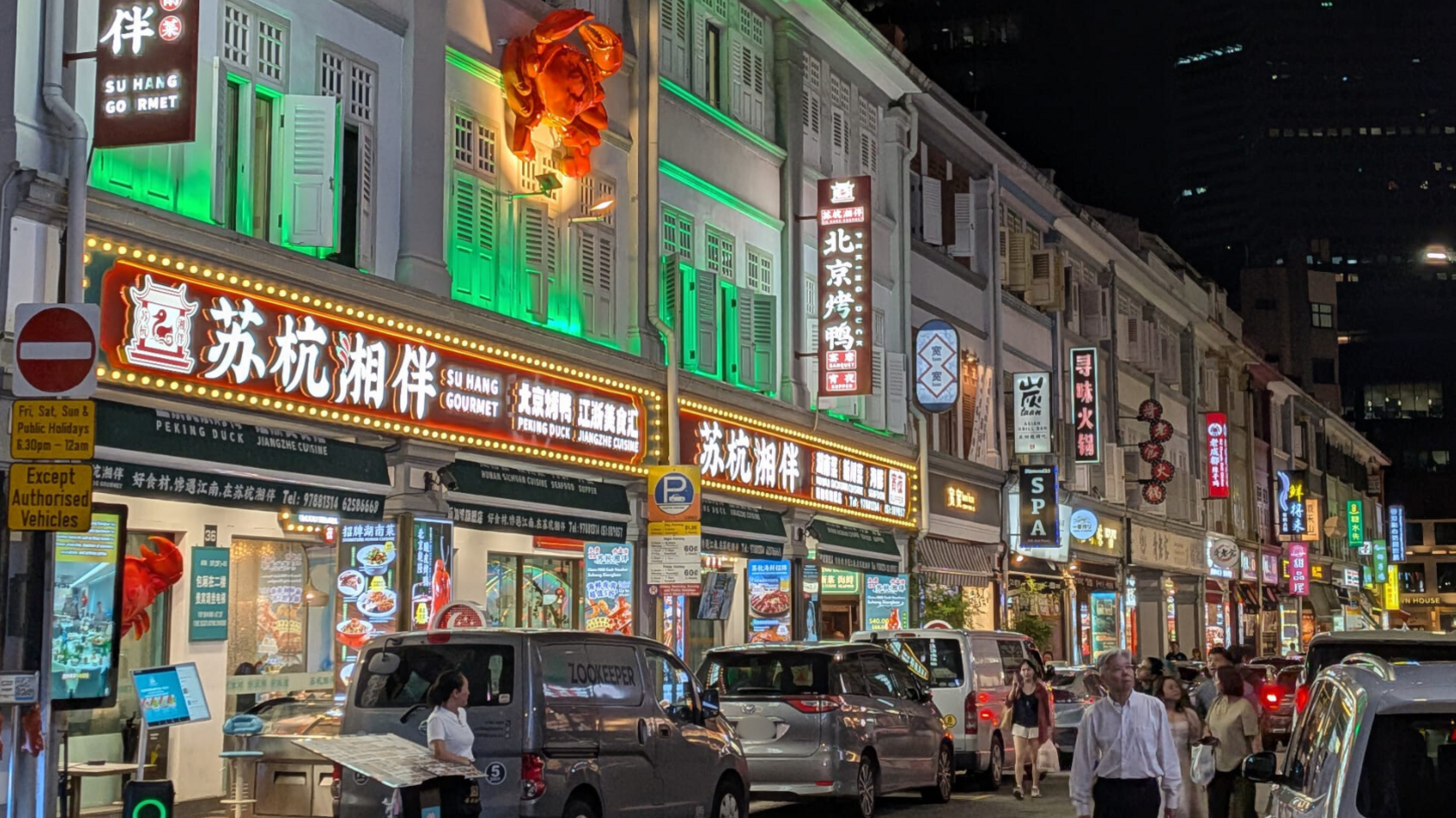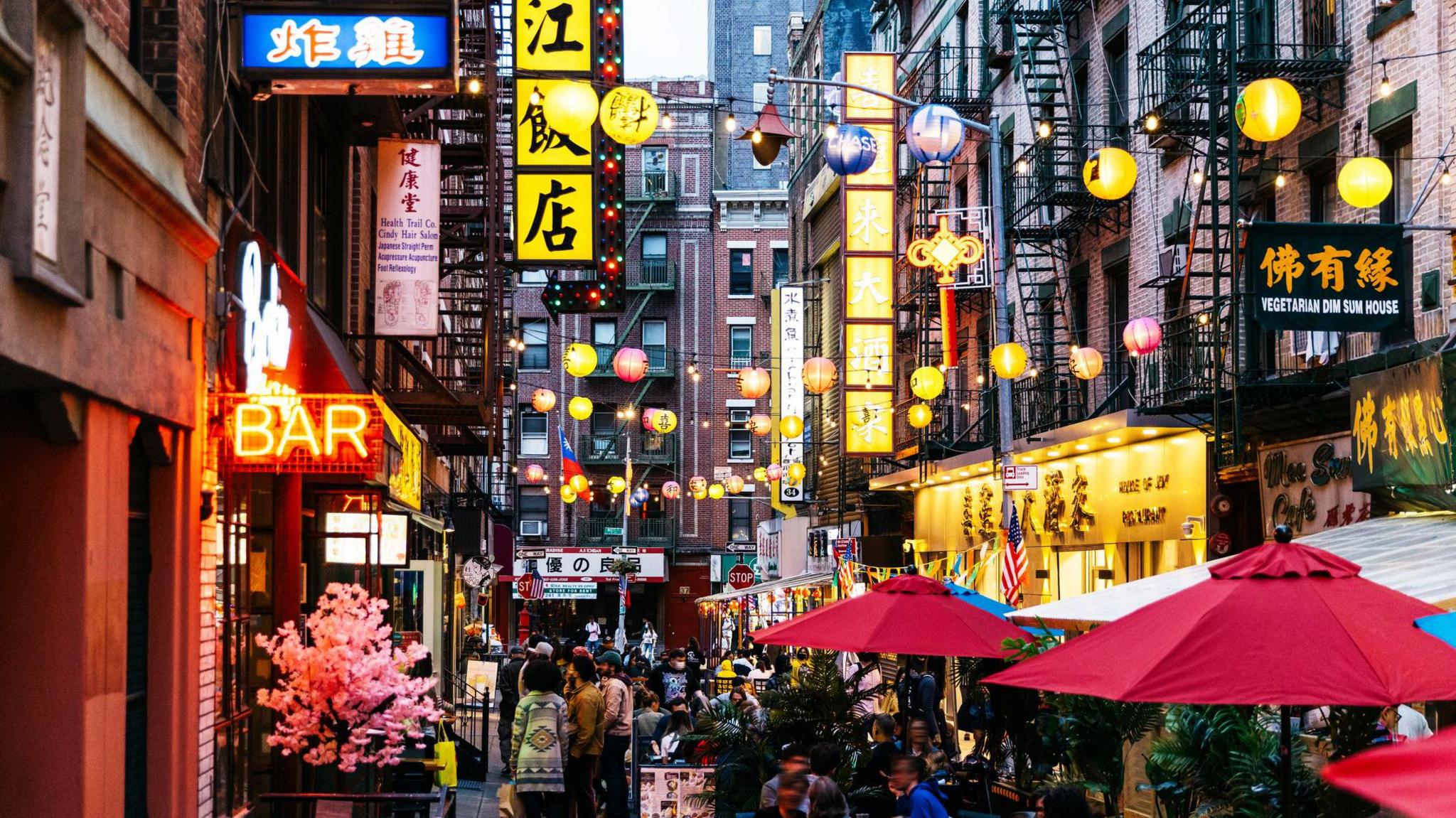Beyond chow mein: Can a new wave of restaurants help China win hearts?

As Chinese restaurant chains boom, they are finding their way to new places
- Published
Grilled fish on a generous bed of numbing chillis and peppercorns from China's south-western metropolis, Chongqing; cumin-laced lamb skewers from Xinjiang in the far north; and fiery rice noodles flavoured with snails from the famed rivers of Guangxi in the south.
All of this on a walk down Liang Seah Street in Singapore.
Chinese food is having a moment outside China, driven by huge success and intense competition back home. And nowhere is this clearer than in Singapore, where ethnically Chinese people make up more than three-quarters of the multicultural population.
The trend is not surprising given that Chinese soft power seems to be on the rise – think viral Labubu dolls, humanoid robots and futuristic cities that are impressing travellers.
Centuries-old and sophisticated, Chinese cooking is not among Beijing's list of priorities for turning the country into "a powerhouse in culture" by 2035.
And yet, as an increasingly authoritarian China tries hard to win the world over, a sumptuous table may just be its most effective, and underrated, draw.
First stop: Singapore
Luckin, China's answer to Starbucks, opened its first overseas store in Singapore in March 2023. Two years on, there are more than 60. Last month, the chain made its US debut with two New York stores.
Five major Chinese brands, Luckin included, currently run 124 outlets in Singapore, double the number they owned in 2023. It's hard to miss the evidence: huge, bright ads of chilli-laced dishes and, sometimes, Chinese idioms, in malls, buses and subway stations.
From established chains to mom-and-pop stores and chic restaurants that challenge tired stereotypes, they have all been taking off here before leapfrogging further afield, to elsewhere in South East Asia and then across the world.
Succeeding in Singapore is "a proof of concept for later expansion, convincing potential investors that the chain is ready to go global," says Thomas DuBois, a historian of modern China.

Singapore's Liang Seah Street is chock-a-block with Chinese food
It's an easy enough place for new restaurants to set up shop. And it is diverse, which makes it a great test kitchen for very different palates, from South Asian to European.
And importantly, Singapore is a travel hub where, Mr Dubois says, eating is almost like a national pastime: "People go to Singapore to eat."
And what they will find is menus that go beyond the ubiquitous dumplings and hot pot. The entrepreneurs behind the new Chinese culinary wave want to show people just how vast and diverse China is. And they cannot fake it.
Many of the visitors to Singapore are ethnic Chinese – not just from China, but from Bangkok, Kuala Lumpur, Manila, Jakarta and so on – with a sophisticated understanding of Chinese cuisine.
There is no one kind of fiery, says Claire Wang, the marketing manager for Nong Geng Ji, a chain from Hunan in central China, which is famous for its spicy dishes.
Hunan's fare has "a tangy aftertaste achieved through fermented chilli peppers", she says, unlike "Sichuan's numbing-spicy or Guizhou's sour-spicy".
After launching more than 100 restaurants in China, Nong Geng Ji opened its first overseas stop in Singapore in late 2023. It has since set up six more here, five in Malaysia, one in Canada, and is now eyeing opportunities in Thailand, Japan, South Korea and the US.
It's certainly proof of the growing appetite for chillies, especially the Chinese kind – a trend that would please China's former leader Mao Zedong. Born and raised in Hunan, he believed, "You can't be a revolutionary if you don't eat chillies".
Finally, 'proper' Chinese food
For the less revolutionary among us, there is plenty more on the table: steamed buns, red meats, preserved vegetables, rice, seasonal stir-fries and delicately flavoured seafood.
It's quite the spread compared to the "Chinese food" much of the world has become used to, especially in the West – food cooked up by Chinese immigrants in the 19th and 20th Centuries, whose scrubby, nondescript restaurants were often seen as low-brow.

Many of these successful Chinese chains have their eye on New York City
The food was simplified to suit local tastes, and that's how the US ended up with un-Chinese staples such as orange chicken and chop suey, and the UK with its chow mein and sweet-and-sour chicken balls.
These very basic, largely made-up dishes "clouded appreciation of the diversity and sophistication of Chinese gastronomic culture", writes Fuchsia Dunlop in her new book, Invitation to a Banquet. Ms Dunlop, a British food writer, has spent her career cooking in China's kitchens and studying its food.
Then there is the stereotype, dubbed the Chinese Restaurant Syndrome, a partly xenophobic myth that the food can make people feel sick because of supposedly high concentration of additives, particularly the flavouring agent MSG. New research suggests MSG does not make you sick, and while older Chinese restaurants probably used shortcuts to flavour, they were hardly unique in using additives.
Now, a growing diaspora is making it possible for Chinese restaurants to stay true to their roots, knowing they have customers demanding "proper Chinese food". And that has coincided with more adventurous palates in the world's biggest cities.
When Thomas Tao was a student in New York in the 2010s, he says he rarely came across Chinese fine-dining, but Americans were very willing to pay for, say, Japanese sashimi.
Now he is the vice-president of the Green Tea Restaurant chain, which has more than 400 outlets in China serving stewed and roasted dishes from Zhejiang. It will open its first outpost in Singapore later this month.
And it goes beyond food, with "immersive" restaurants. Diners listen to the guzheng, a Chinese zither, while they sit at boat-shaped tables surrounded by landscapes around the West Lake, an icon of the coastal province.
"We want to help people be more accepting of our culture and uplift the image of Chinese cuisine," Mr Tao says.

The entrepreneurs behind the new wave of restaurants want to show off a range of Chinese cooking
It is not the only chain to try this. Sichuan Alley, which opened its first outlet in New York last year, is inspired by "alley culture" characteristic of early 20th Century Chengdu – a warren of old streets where people mingled and feasted.
Food tells the story of a people, and short of visiting a place, it is perhaps the best glimpse into it.
So can the Chinese table help soften the image of a country whose ambitions often clash with those of Western powers and neighbours?
The price of soft power
In her book, Dunlop cites one of her readers suggesting that Beijing could more effectively project its soft power by "changing its controversial overseas Confucius Institutes into top-notch Chinese restaurants".
Beijing is battling plenty on the international front: Trump's tariffs, alleged espionage plots and a world that is wary of its economic might.
Even this explosion in Chinese restaurant chains is worrying local businesses in Singapore who wonder if they can keep up.
Stiff competition in China and a spending dip are forcing these chains offshore. And their pace of expansion is insatiable – they bring with them a reliable supply chain, marketing acumen, and deep pockets that allow them to sacrifice profit.
And they have a playbook. First you are encouraged to sign up for a free membership that gets you a discount. The meals come with a free flow of tea, dipping sauces and pickled vegetables.
The winner? Unlike in most Singaporean restaurants, tissues – much-needed after a spicy meal – are free.
It is not the first time the exports of China's success have sparked anxiety in its smaller South East Asian neighbours. It has already happened with plenty of Chinese imports, from clothing to gadgets.
But food, some believe, can sweeten that deal.
"Chinese people take great pride in their culinary culture, which also serves as a powerful form of diplomacy," says Felix Ren, director of Singapore-based food consultancy WeMedia.
He is encouraged by the table tennis matches that helped thaw historic tensions between Beijing and Washington in 1971.
"Chinese cuisine," he says, "may just be the new ping-pong diplomacy."
- Published20 June

- Published4 January

- Published17 July

